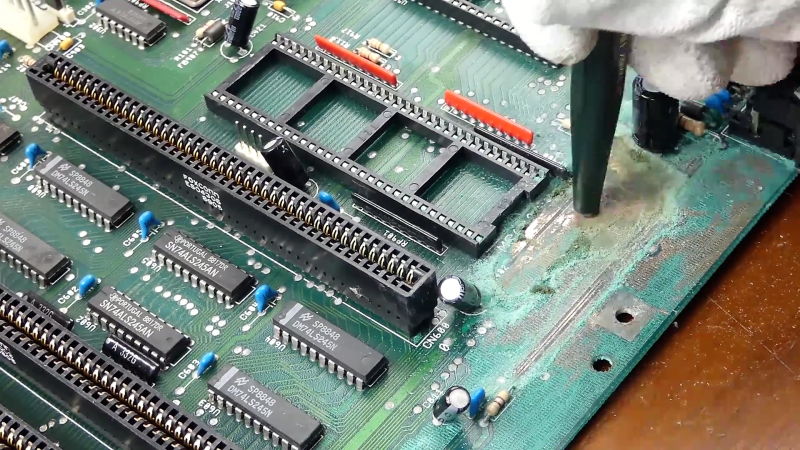Returning a piece of retro hardware to factory condition is generally a labor of love for the restorationist. A repair, on the other hand, is more about getting a piece of equipment back into service. But the line between repair and restoration is sometimes a fine one, with the goals of one bleeding over into the other, like in this effort to save an otherwise like-new Amiga 2000 with a leaky backup battery.
Having previously effected emergency repairs to staunch the flow of electrolyte from the old batteries and prevent further damage, [Retromat] entered the restoration phase of the project. The creeping ooze claimed several caps and the CPU socket as it spread across the PCB, but the main damage was to the solder resist film itself. In the video below you can clearly see flaky, bubbly areas in the mask where the schmoo did its damage.
Using a fiberglass eraser, some isopropyl alcohol, and far more patience than we have, [Retromat] was able to remove the damaged resist to reveal the true extent of the damage below. Thankfully, most of the traces were still intact; only a pair of lines under the CPU socket peeled off as he was removing it. After replacing them with fine pieces of wire, replacing the corroded caps and socket, and adding a coin-cell battery holder to replace the old battery, the exposed traces were coated with a varnish to protect them and the machine was almost as good as new.
Amigas were great machines in their day and launched more than one business. They’ve proved their staying power too, some even in mission-critical roles.
















Nice job, :) ..it might be beneficial to tin those exposed copper traces with tin solder for long term protection. And as a side note, for longevity of repair, it is sometimes wiser to use a patch wire running from the last good solder point to the socket pins (rather than trying to recreate the missing trace) as these fixes can be more robust to future physical vibrations / board flex, etc.. :D But Nice one – Another Amiga up & running! ^_^
Thanks :) I actually tinned the area below the crc adapter and added tin over the bad corroded line nearby the battery. The traces i covered with a few drops of epoxy so they stay in place for hopefully a looong time :) The pcb coating thould do the rest but yes it would have been easier going from point to point but hmm.. this way it loks kinda cleaner :)
Do you then cut the original trace so it doesn’t end up as an antenna or am I talking out of my ass ?
Always found leaded solder is easier to fix traces with than lead free #controversial
All i did was restoring the original traces where it belongs connected to :) I doubt anything will act as antenna there, this board is surrounded by a case of a few mm thick solid metal and afterall the error margin on the operations of those machines is really really high.
I usually cut the original trace after I repair it because like you say, it does sometimes act like an antenna. I mainly work on audio gear though these days so it is probably a more pronounced effect. Not sure about the lead/non-lead trace repair but may give it a shot and see how it goes.
Kudos to Retromat for getting this beast humming again :)
No I was referring more to the physical strength of repair. Fixing traces can leave fragile, rigid features that fail again due to future physical stress. Point-to-point patch wires, while looking messy – actually provide future proof fixtures. :) At the low speed of these older circuits (sub or circa 10 Mhz) the RF effects of trace segments are quite negligible. (Unless it’s the signal clock path / resonator circuit)
That and the number of these old circuits where rework wire was common from the factory, one could point to point some fine wire and tack it down with some hot glue and it would not look out of place, although I know from a timing perspective the data lines you pretty much want them all as close to the same length as possible (Probably not as critical with an Amiga though)
If I had the patience to do what you did, I would still have my A2000. Really good job on the repair. Schoen gemacht!